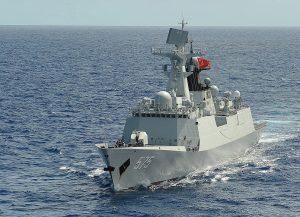Trans-Pacific View author Mercy Kuo regularly engages subject-matter experts, policy practitioners, and strategic thinkers across the globe for their diverse insights into U.S. Asia policy. This conversation with Dr. Collin Koh Swee Lean – research fellow and coordinator of the United States Programme, Institute of Defence and Strategic Studies at the Rajaratnam School of International Studies at the Nanyang Technological University in Singapore – is the 236th in “The Trans-Pacific View Insight Series.”
Identify three key takeaways from the recent U.S. government report “China’s Naval Modernization: Implications for U.S. Naval Capabilities.”
First, the PLA Navy is projected to muster 360 battle force ships, against the U.S. Navy’s 297 by the end of FY2020, and this number is further projected to increase to 400 by 2025, and 425 by 2030, even though it’s necessary to point out that “bean-counting” the number of ships merely constitutes one dimension of measuring naval capability.
Second, China’s naval ships, aircraft, and weapons are now much more modern and capable than they were at the start of the 1990s and are now comparable in many respects to those of Western navies.
Third, the PLA Navy is modernizing on multiple fronts, not just in terms of platform and weapon acquisition programs ̶ existing new assets are comparable in many respects to those of Western navies ̶ but also improvements in maintenance and logistics, doctrine, personnel quality, education and training, and exercises, and it is quickly addressing deficiencies in these areas while at the same time, the Coast Guard is also expanding significantly. The PLA Navy poses a major challenge to the U.S. Navy’s primacy and ability to achieve and maintain wartime control of blue-water ocean areas in the Western Pacific.
What salient shifts, if any, in U.S. Navy strategic priorities vis-à-vis China caught your attention?
A notable salient shift in the U.S. Navy’s strategic priorities vis-à-vis China would be adjustment of a future force structure to a more-distributed fleet architecture that will feature a smaller portion of larger ships, which have been the mainstay, and instead, a larger portion of smaller ships, and a substantially greater use of unmanned platforms. The other salient shift is the focus on developing new operational concepts to employ both the Navy and Marine Corps to counter China’s anti-access and area denial capabilities.
Explain the impact of China’s naval modernization on Singapore and Southeast Asia writ large.
The modernization of China’s maritime forces ̶ both the PLA Navy and China Coast Guard ̶ ought to be seen in the context of the broader Sino-U.S. rivalry in Southeast Asia and, of course, the evolving situation in the South China Sea. Broadly speaking, intentions change more quickly whereas naval capabilities take time to modernize. China would persist in widening the naval power asymmetry with its Southeast Asian rivals especially in the South China Sea. Seen in the context of Beijing doling out diplomatic niceties and economic cooperation on the one hand and continuing with coercion at sea on the other, this has presented more uncertainties for Southeast Asian governments, not just Singapore. And for a region that has long relied on the primacy of American military presence as an offshore balancing force of sorts, given the closing of capability gaps with the U.S. Navy seen in the context of intensifying Sino-U.S. geopolitical competition, the future durability of Washington’s commitment towards Southeast Asia, and its continued ability to serve as an effective counterweight against China’s growing military might and assertiveness, is at stake.
Evaluate Singapore’s strategic calculus in balancing the rise of U.S.-China rivalry.
In recent times, some officials from within the Trump administration and American think-tanks have criticized Singapore for sliding more toward Beijing. This is not true. Singapore has a well-known, long-avowed foreign policy of not choosing sides between China and the U.S. – which would not change for the foreseeable future. For long, Singapore has prioritized the development of diplomatic, sociocultural, and most crucially economic ties with China on the one hand, and defense and security partnership with the U.S. on the other. This bifurcation of priorities is becoming more tenuous in recent times. China not only wants to maintain and enhance its strong economic ties with Singapore, but also desires more in the realm of defense and security partnership, which is why both countries have lately ramped up cooperation in the latter dimension. But there are still clear practical and political limitations as to how far it goes. At the same time, we observe that Singapore is also enhancing its defense and security partnership with the U.S., such as plans for a permanent air force training detachment in Guam and extending the 1990 MOU to allow continued American access to Singapore’s military facilities, not least Changi Naval Base. Clearly, while trying to help sustain the U.S. military commitment to the region, Singapore seeks to assuage Beijing’s concern that it is part of a U.S.-led containment scheme; a good example is how the island city-state has been an ardent supporter of China’s Belt and Road Initiative.
Assess geopolitical risks of U.S.-China naval competition in Southeast Asia.
There are definitely concerns that the Sino-U.S. naval competition would ultimately result in an outright armed confrontation, while at the same time there’s general support in Southeast Asia for continued American military presence, not least in the South China Sea. The risk of premeditated armed confrontation is relatively low, given that even in times of tensions, American and Chinese militaries continue to maintain some channels of communications. The more prevalent risk, however, would be inadvertent and accidental clashes between the U.S. and Chinese navies as a result of miscalculation and misjudgment of the situation by forces on scene.

































